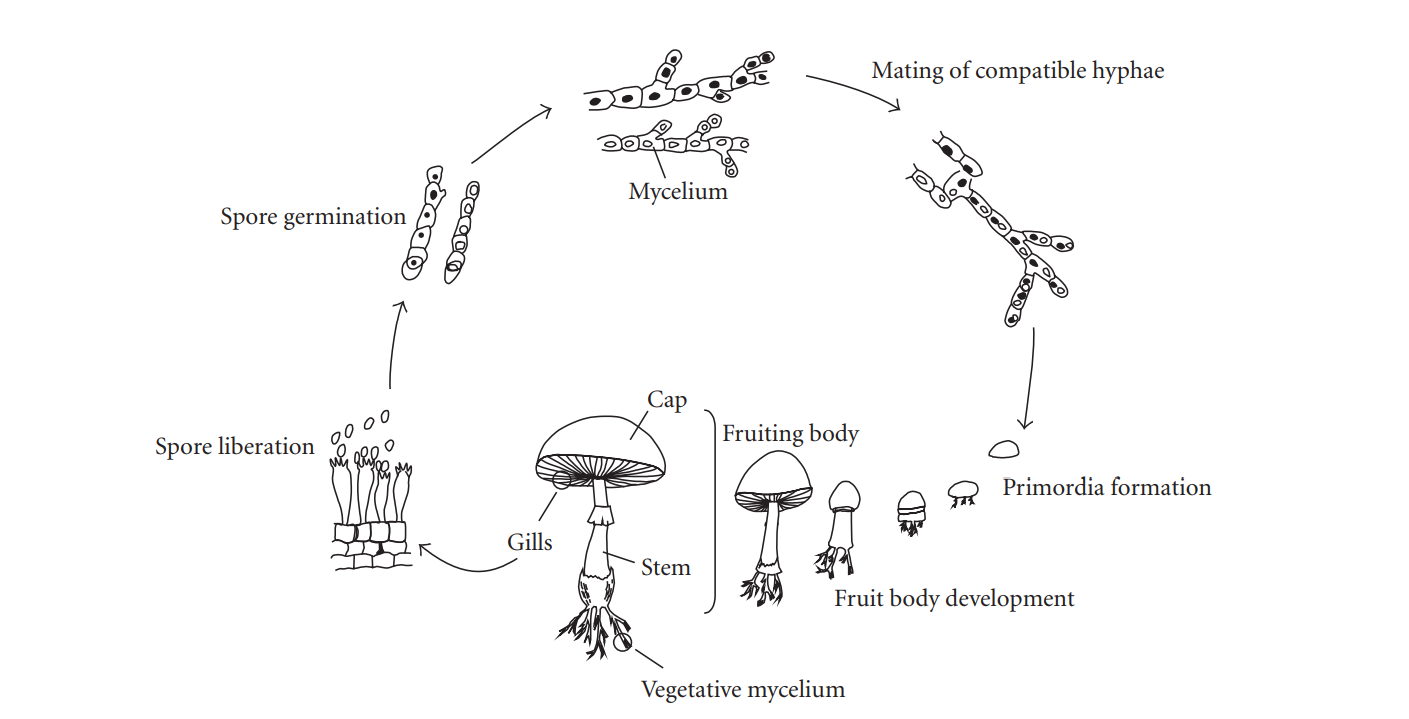project04:Material Study
Material Studies
Introduction
This project revolves around the growing of architecture by application of mycelium. Mycelium is the vegetative part of fungi. This biological tissue/ material is composed from tube-like fibers. These fibers are called hypha and are approximately 1 lm in diameter. Hypha grow by elogation of the apical tip. Which means that the fibers grow faster in the tips than in its branches. On occasion these fibers branch out and merge with other hyphae. As a consequence a random fibernetwork structure is formed; The mycelium (Lull et al., 2005).
Mycelium can be grown in multiple forms, (pure) mycelium, synthetic mycelium and composite mycelium. The last one will be the main focus of this material study since this is the form that is most used within the product development and the built environment. The composite is a mixture of mycelium mixed with a organic substrate most preferably a lignocellulosic biomass. Mycelium than forms it's network of hyphae on and through the substrate by (partly) consuming the substrate. It then transforms the substrates biomass into chitine (up to 45%), Protein and polysacharides. As a result of this process mycelium and the substrate are bonded into the mycelium composite (Tazelaar, 2017).
Biological Properties
Lifecycle of fungi
Since fungi is a living organism the species goes through the cycle of life. In order to produce and reproduce mycelium knowledge of it's cycle is required. The image below portaits the lifecycle of the fungi.

This image is based on a image from (Lull et al., 2005)
Bakker, L. (2019). Fungi Lifecycle. Own Image
Species
The taxonomical kingdom of fungi is vast. Within the this kingdom you can find species that act as food, produce medicine or in case of this research as building material. Form all the different taxonomical divisions on division is particularly intressting, this is the basidiomycota division. The reason why this division is so intressting is because of its ability to break down long and complex organic moleculs. The species that are most often used within this field are the Oyster mushroom (Pleurotus ostreatus, "Oesterzwam" (NL)), the Split Gill (Schizophyllum commune, "Waaiertje" (NL)), Lingzhi mushroom (Ganoderma lucidum, "Gesteelde lakzwam"(NL)) and the Turkey tail (Trametes versicolor, "Gewoon elfenbankje" (NL)). The choices for these fungi are chosen due to their benifitial properties towards growth, strenght and ability to consume specific nutritions for example (Jones et al., 2018) (Tazelaar, 2017).
Growth properties
Fungi live on organic materials, some tend to eat plastic, some clean soil.
Structural Properties
Structural properties
The usage of mycelium as a building component is relatively new. Therefor there is not much research available involving this subject. Besides that mycelium is a biocomposite with many different possibilities for substrate, that fact makes it even more harder to determine average structural properties. In the table below structural properties are shown of mycelium in comparrision to EPS and concrete. EPS is shown since the characteristics of mycelium and EPS are very similiar as are their usages within product development. While concrete is shown as it is a widely used within the build environment.
As seen the structural properties are very similair when it comes down to their compressive strengths. While the young's modulus shows that mycelium is more flexible than EPS. With the mycelium flexibility it is also able to better deal with flexural forces than EPS. But the best the reason why mycelium is better for usages than EPS is its low energy consumption for production and it's biodegradable properties.
| Mycelium Composite | EPS | Concrete (C53/65) | |
|---|---|---|---|
| Density [Kg/m3] | 122 | 20 | 2500 |
| Compressive strength 10% [MPa] | 0,12 | 0,10 | 65 |
| Tensile strength [MPa] | - | 0,15 | 2,13 |
| Flexural strength [MPa] | 0,23 | 0,15 | 4,30 |
| Young's modulus [MPa] | 1,14 | 6,00 | 37300 |
This table is based on information from (Cement&BetonCentrum, n.d.) and (Tazelaar, 2017)
Composites Enhancement
Joining of materials
In order to join mycelium you can let it grow on other living mycelium parts
Environmental Properties
Vezel Emissie broeikasgas [t CO2/t vezel] Primair gebruik energie [GJ/t] Carbon 1,7 290 Glas 2,2 35 Vlas/Hennep 0,714286 5-10
Waterproof
Windproof
Fire safety
Jones et all (2018) did a research into the fire safety of mycelium components. decomposition temperatures, residual char, and gases evolved during pyrolysis. The thermal degradation and fire safety of mycelium and mycelium-wheat grain composites have been characterised using various experimental techniques. Thermogravimetric analysis revealed that the growth time has no discernible effect on the thermal degradation characteristics of mycelium. FTIR and GCMS analysis have identified the complex thermal degradation patterns accompanied by the release of multiple flammable and non-flammable gaseous products. The fibrous structure of mycelium is retained following pyrolysis, albeit with a reduction in its diameter. The fire reaction properties of mycelium have found to be superior to other competing thermoplastic polymers (PMMA and PLA) due to its tendency to form relatively higher char yields. The presence of mycelium is responsible for an improvement in the fire reaction properties of wheat grains. However, beyond 6 d, the growth time has been found to have no significant effect on the fire reaction properties of mycelium-wheat grain composites. Mycelium has been found to possess certain flame-retardant properties (e.g. high char residue and release of water vapour) and could be used as an economical, sustainable and fire-safer alternative to synthetic polymers for binding matrices.
Acoustics
Insulation
0,04 W/MK Mycelium 2,60 W/MK Concrete
Resistance to Toxins
Biodegradation
Effect on the ecosystem
Comperision to concrete, styrofoam. Usage of waste streams.
Waste production.
In order to produce mycelium based products.
Applicational Properties
Aesthetics
Patterns
Machine Alterations
Biovoltaics
Product lifecycle
Pure mycellium and composite mycelium